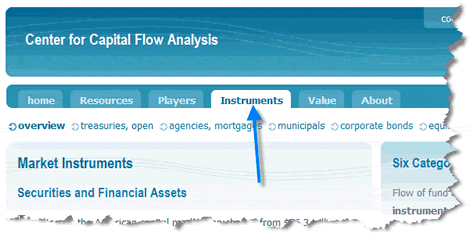 How to Read Flow of Funds Accounts
How to Read Flow of Funds Accounts
Reading Flow Sheets for Capital Flow Analysis
In this module, we show you how to apply Capital Flow Analysis to the Federal Reserve national flow of funds accounts, step by step.
Your first task is to learn to use this site so that you can organize and access your research materials easily.
You can easily organize and access your research materials.
In this lesson you will learn how to use this site to drill down and quickly focus on the instrument table you need to explain the market.
Although you can download flow of funds accounts from the Federal Reserve site, it is more convenient to use resources on our pages.
Here's why:
- Easier and Faster: Our flow of funds tables are color-coded for quick analysis. Color-coding guards against common mistakes such as misinterpreting a minus sign;
- Customized for Capital Flow Analysis: National flow of funds accounts serve purposes beyond Capital Flow Analysis. For example, NIPA sections are not the primary focus. In our tables, NIPA data is shown on a grey background, putting attention on data that is relevant.
- Integrated Links and Definitions: Each table on this site is associated with links to current data from governmental and private sources, and an official definition for the table.
- For example, when reading the flow table for mutual funds, you can quickly find links to the Investment Company Institute, a source of up-to-date information not yet published by the Federal Reserve.
- This may not seem like a big deal, until you realize that we publish tables on thirty sectors and instruments, each with a number of useful sources of additional or more current information.
Start With An Instrument Table
The first thing in Capital Flow Analysis is to decide which market you are going to examine.
This means that you need to start by looking up the appropriate instrument table.
In flow of funds jargon, "instruments" are kinds of securities, such as corporate equities, mortgages, municipal bonds, or open market paper.
On this site, we present color-coded tables on nine classes of securities that account for most of the financial market:
Equity Instruments:
Fixed Income Instruments:
F.206 Money Market Mutual Fund Shares
F.211 Municipal Securities and Loans
Cliick on these links to see what instrument flow tables took like.
Navegating To An Instrument Table
From most pages on this site, you can reach an instrument definition page in three clicks or less.
First, click the instrument tab at the top of the page.

This opens a horizontal navegation bar with six groups of instruments:
- Treasury securities and open market paper; (2)
- Agency securities and mortgages;(2)
- Municipal bonds and loans;
- Corporate bonds;
- Corporate equities;
- Fund Shares. (2)
Three of these groups have a single instrument table, and three include two tables.
Follow the links on the horizontal bar and you will find the category you're looking for.
Before proceeding, check your progress:
Self-Test
Which statements are true?
|
|
Which are instruments?
|
|
To find the flow table for corporate bonds, click on:
|
 How to read flow of funds accounts : continued >
How to read flow of funds accounts : continued >
